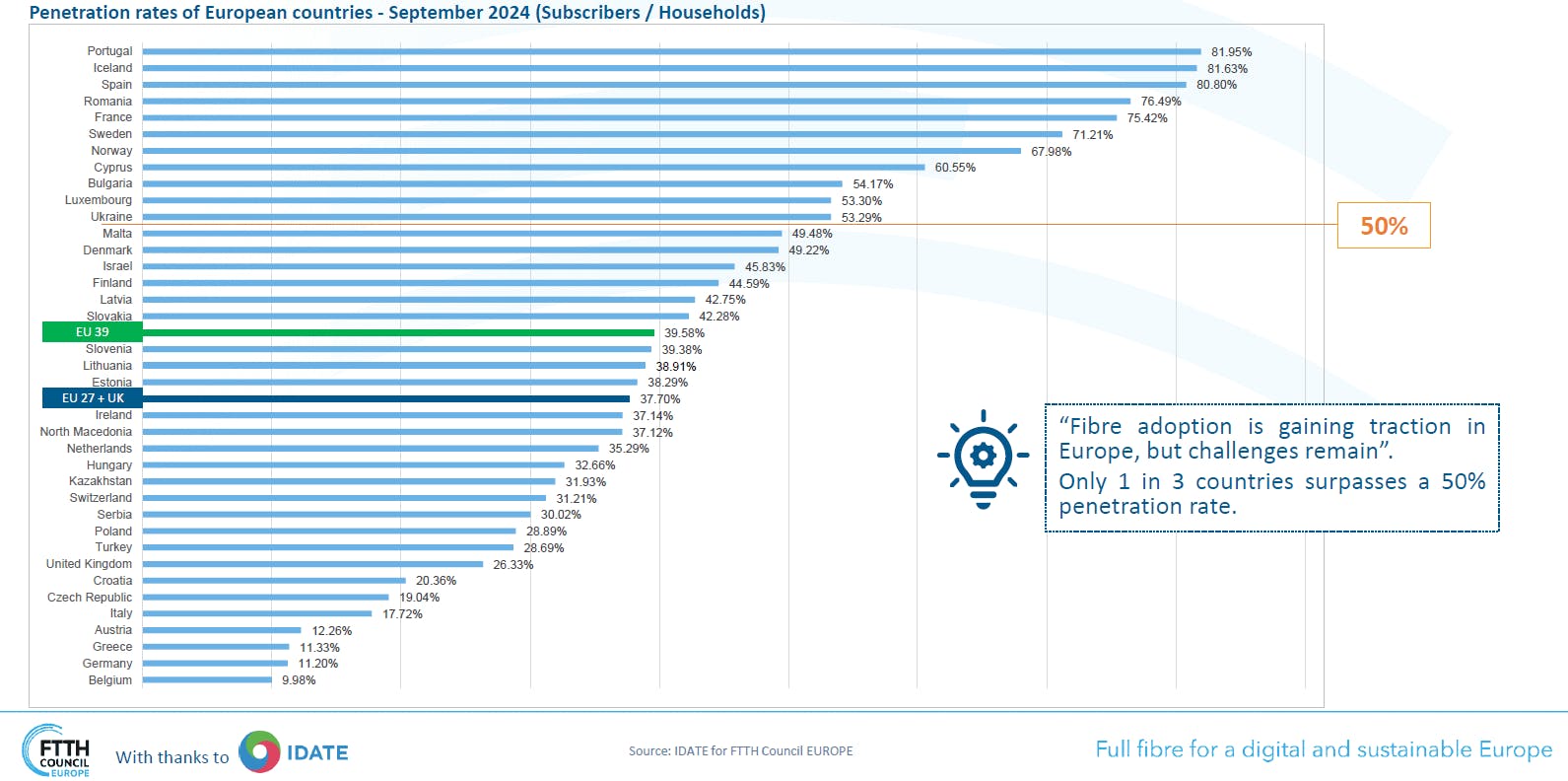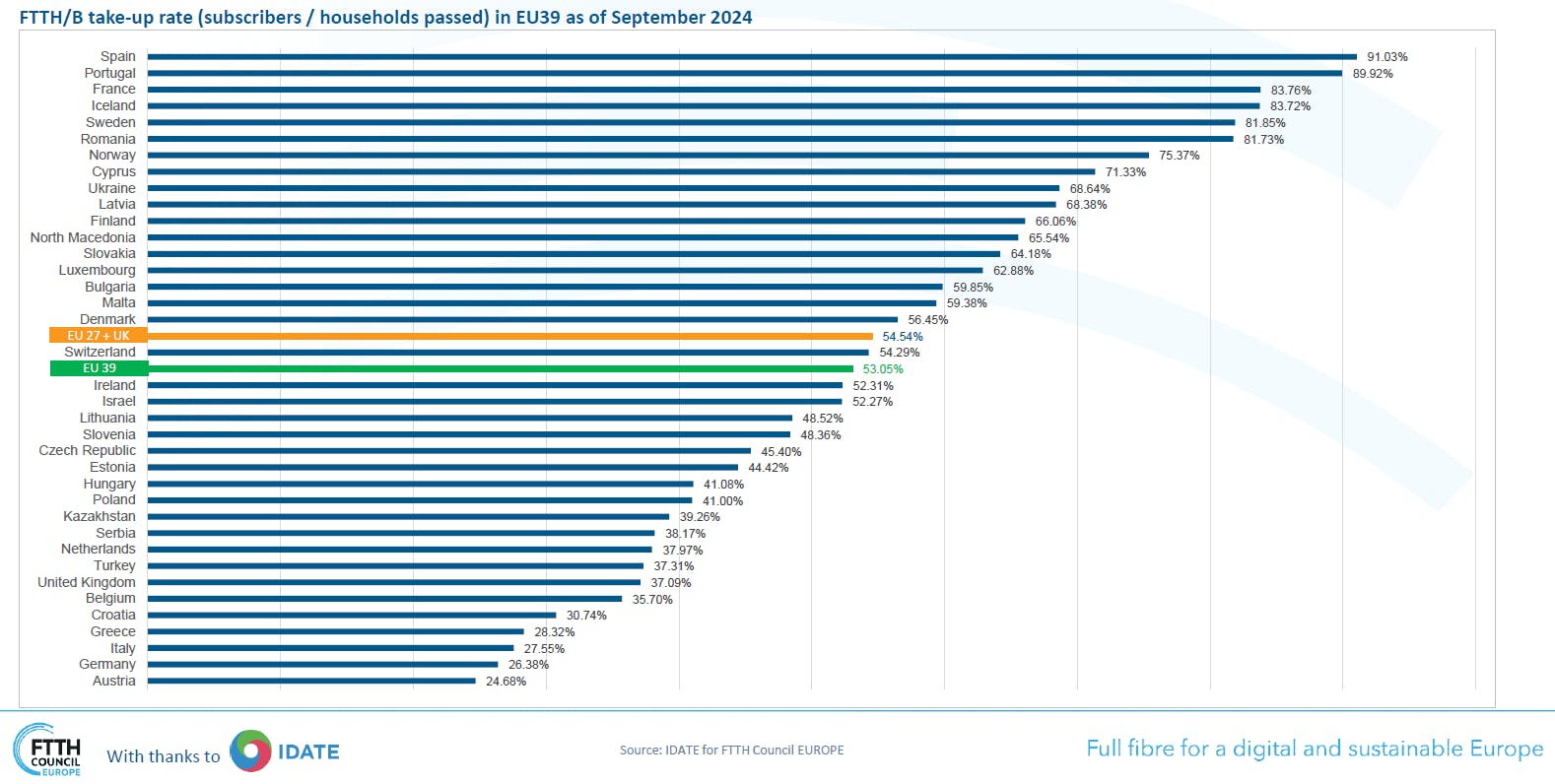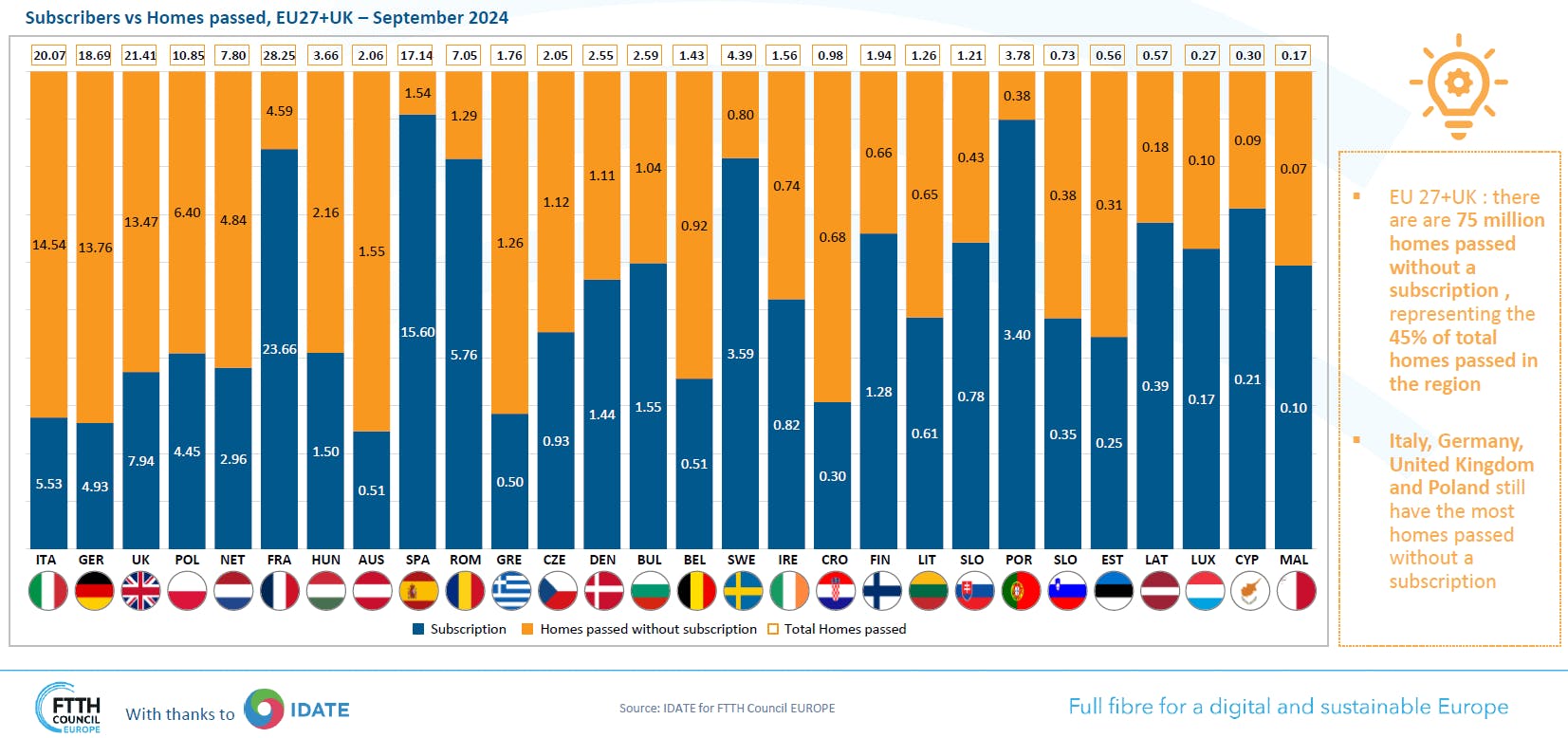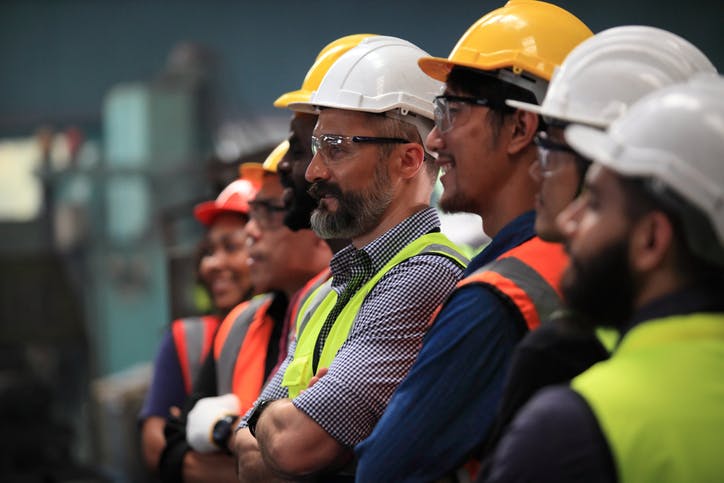As fiber optic providers in the EU push to meet the ambitious goal to provide fiber-to-the-home or business (FTTH/B) gigabit connectivity to everyone by 2030, they face mounting challenges including fierce competition, network overbuild, and market consolidation. Though the Digital Decade initiative is driving public and private investment in fiber optic network expansion, many network builds are wrapping up, putting increased pressure on providers to start generating revenue sustainably.
In its FTTH/B Market Panorama 2025, the FTTH Council Europe provides insight into network coverage and take-up gaps across Europe and identifies the nations that are struggling to keep pace. With this information, FTTH network operators can spot opportunities to extend networks into underserved regions, assess the risk of overbuild, and better understand the competitive landscape as they work to win subscriptions.
However, the numbers reported in the Market Panorama only tell part of the story. In this review, we will provide greater context around key statistics and trends and discuss how fiber providers can overcome FTTH market challenges in the EU and pull ahead in this highly dynamic market.

Overall Coverage Gaps are Closing but the Penetration Rate Remains Low
Nearly 75% of households in the EU39 have access to a fiber network, but only around 40% of all households are subscribed. Among the homes that have coverage, the overall take-up rate sits at a promising 53.05% percent. The race is on to increase last-mile FTTH deployments, roll out fiber in hard-to-reach areas, and drive subscriptions.
Governments continue to prioritize gigabit expansion in rural communities. For example, the UK government awarded Openreach with £800 million in contracts to improve broadband connection in rural areas. Germany recently announced its €1.2 billion 2025 Gigabit Funding Program with a focus on improving rural fiber infrastructure.
Just one in three countries in the EU 39 have surpassed a 50% penetration rate. Low penetration should serve as a signal to providers as they complete their network builds to shift their attention onto optimizing their business models for revenue and improving marketing and customer experience. Large operators across the EU are beginning to decommission their copper lines to incentivize customers to make the switch to fiber.
Fiber Optic is Growing Faster Than Ever Despite a Slowdown in Investment
The FTTH/B Market Panorama 2025 reveals that network coverage and subscriptions increased more than they have in previous years. Coverage is up 22% since 2023, with 269 million homes passed while subscriptions increased by 29%, with 143 million subscribers across the EU39. Between 2022 and 2023, the rate of change was just 11% and 14%, respectively, mirroring the rate of change between 2021 and 2022 when coverage increased by 12% and subscriptions by 13%.
Fiber operators are growing despite facing high interest rates and labor costs and receiving less investment than they have in previous years. This could indicate that operators are finding better ways to generate revenue, cut costs, and increase efficiency. It seems like those strategies are here to stay. According to FTTH Council Europe data, most leaders are anticipating only moderate or slight growth in investment over the coming three years.
Countries Leading the FTTH/B Market in Europe
Portugal, Iceland, and Spain Lead Penetration Rates
Portugal has an 81.95% penetration rate, followed by Iceland at 81.63%, and Spain at 80.80%. Shared infrastructure deals in Portugal support steady expansion, enticing customers to make the switch. A global pioneer in internet connectivity, Iceland recently dedicated €3 million to increase fiber expansion into rural areas to achieve 100% coverage by 2026.

Spain, Portugal, and France Lead Take-Up Rates
Spain leads with a 91.03% take-up rate and Portugal isn’t far behind at 89.92%. Both countries have been phasing out legacy copper lines, driving customers towards faster FTTH options. In 2024, France -with a 83.76% take-up rate- joined them in decommissioning copper in line with the government’s Plan Très Haut Debit which aims to make fiber connections available to all citizens this year. France deployed 17.39 million sockets into customer homes, the most deployed in the EU in 2024.

Which Countries Have the Most Work Left to Do?
Germany, Italy, and the UK Have the Most Homes Left to Pass, and the Most Homes without Subscriptions
While these three countries have work to do to expand network footprints, they also earned the top gains in homes passed in 2024. The UK added 4.22 million homes, Germany added 3.78 million, and Italy extended coverage to 3.14 million residences. Both the UK and German governments are investing in their nations’ fiber networks to pull ahead. Meanwhile in Italy, Open Fiber recently announced it would invest €10 billion over the next decade to improve fiber coverage in the country.
Belgium, Germany, and Greece Have the Lowest Penetration Rates
Belgium has the lowest penetration rate at 9.98%, Germany is at 11.2%, and Greece has 11.33%. Belgium and Greece also have the lowest coverage rates in the EU39 at 27.95% and 40.00%, respectively. Belgians are happy with connectivity through its fixed network cables and aren’t incentivised to switch but the Belgian government is prioritizing measures to speed up network expansion. With just 40% coverage, the FTTH market in Greece is still maturing. Despite low penetration, Greece achieved a 26.48% increase in homes passed and a 60.52% increase in socket deployment in 2024.

Austria, Germany, and Italy Have the Lowest Take-Up Rates
Austria faces significant challenges rolling out fiber, with a coverage rate of just 49.66% and a take-up rate of 24.68%. Issues with government subsidies for broadband in the nation are slowing network expansion and adoption. Germany and Italy are only slightly further ahead, with take-up rates of 26.38% and 27.55% respectively.

How Fiber Optic Providers Can Pull Ahead and Make Progress on Digital Decade Goals in 2025
Maintain Quality Standards Through Last-Mile Deployment and Consolidation
Prioritizing high quality standards within new network deployments and last-mile FTTH connections throughout this period of rapid growth will be crucial for providers in both mature and emerging markets. As companies consolidate, keeping standards consistent across the network will preserve operational efficiency and increase customer satisfaction. Operators can use Deepomatic’s Visual AI to enforce quality standards in the field using photos taken by technicians. Each photo is analysed based on your organization’s unique quality and compliance requirements. Technicians receive real-time feedback so you can eliminate the need for ongoing coaching around quality standards, allowing you to ensure all jobs are completed to the same standard at scale the first time.
Address Labor Shortages and Skills Gaps
A lack of skilled workers holds back fiber rollouts. Optimizing training programs, streamlining field work, and providing excellent employee experiences enables providers to scale field operations faster. With a computer vision solution like Deepomatic, operators can provide AI-driven coaching to technicians out in the field and eliminate the need for manual reporting with automation. Deepomatic’s Visual AI platform also automates back-office quality control processes. It can analyze a high volume of photos for errors so you don’t have to hire on more quality assurance team members.
Drive ROI in Hard-to-Reach Areas
Building and maintaining fiber networks in hard-to-reach communities can be more expensive. In areas with a low population, there may be low potential for growth. A solution like Deepomatic can help providers reduce the costs associated with deploying networks in remote regions. When technicians can do their job correctly the first time, you don’t have to make expensive revisits. Deepomatic makes it easy to collect insight-rich data on your network footprint and asset inventory, so you can get a clear view of your network no matter how far away your FTTH connections reach.
Book a demo to see how Deepomatic can transform your field operations →





